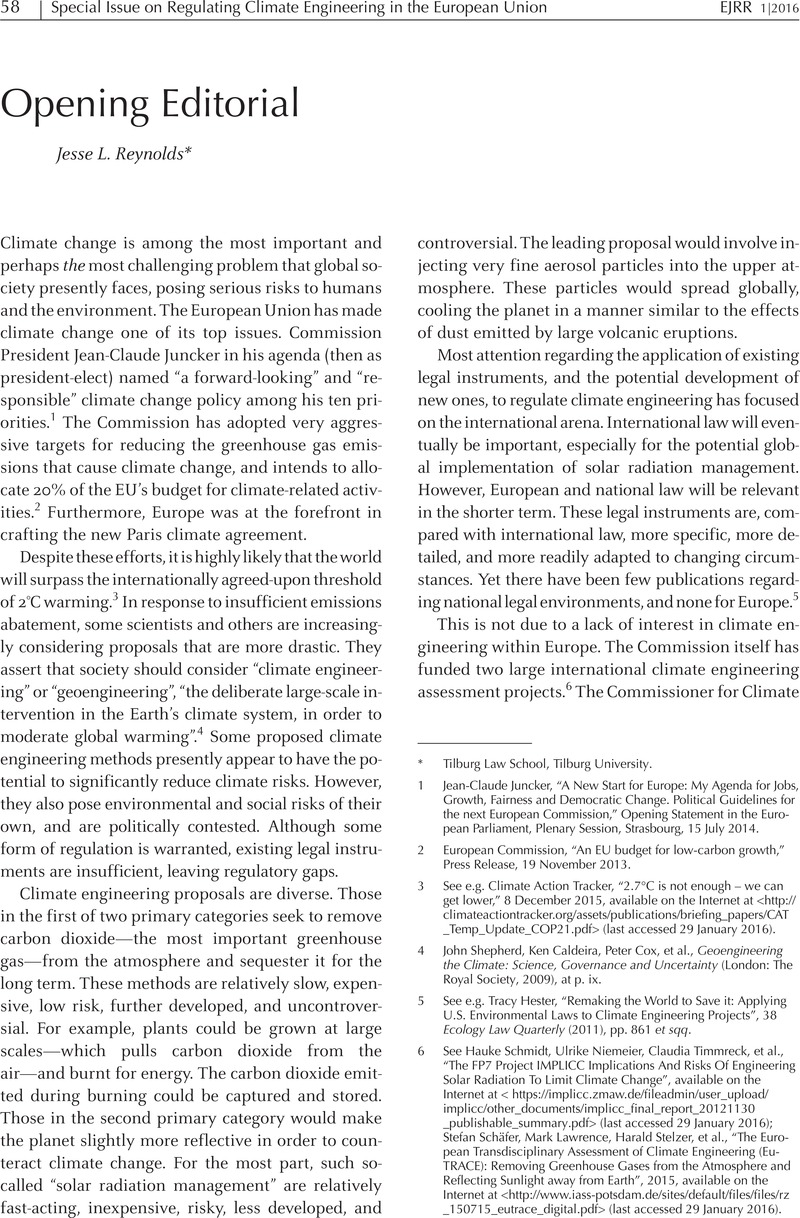Article contents
Opening Editorial
Published online by Cambridge University Press: 20 January 2017
Abstract

- Type
- Special Issue on Regulating Climate Engineering in the European Union
- Information
- Copyright
- Copyright © Cambridge University Press 2016
References
1 Jean-Claude Juncker, “A New Start for Europe: My Agenda for Jobs, Growth, Fairness and Democratic Change. Political Guidelines for the next European Commission,” Opening Statement in the European Parliament, Plenary Session, Strasbourg, 15 July 2014.
2 European Commission, “An EU budget for low-carbon growth,” Press Release, 19 November 2013.
3 See e.g. Climate Action Tracker, “2.7°C is not enough – we can get lower,” 8 December 2015, available on the Internet at <http://climateactiontracker.org/assets/publications/briefing_papers/CAT_Temp_Update_COP21.pdf> (last accessed 29 January 2016).
4 Shepherd, John, Caldeira, Ken, Cox, Peter, et al., Geoengineering the Climate: Science, Governance and Uncertainty (London: The Royal Society, 2009), at p. ix Google Scholar.
5 See e.g. Hester, Tracy, “Remaking the World to Save it: Applying U.S. Environmental Laws to Climate Engineering Projects”, 38 Ecology Law Quarterly (2011), pp. 861 et sqq Google Scholar.
6 See Hauke Schmidt, Ulrike Niemeier, Claudia Timmreck, et al., “The FP7 Project IMPLICC Implications And Risks Of Engineering Solar Radiation To Limit Climate Change”, available on the Internet at < https://implicc.zmaw.de/fileadmin/user_upload/implicc/other_documents/implicc_final_report_20121130_publishable_summary.pdf> (last accessed 29 January 2016); Stefan Schäfer, Mark Lawrence, Harald Stelzer, et al., “The European Transdisciplinary Assessment of Climate Engineering (Eu-TRACE): Removing Greenhouse Gases from the Atmosphere and Reflecting Sunlight away from Earth”, 2015, available on the Internet at <http://www.iass-potsdam.de/sites/default/files/files/rz_150715_eutrace_digital.pdf> (last accessed 29 January 2016).
7 Miguel Arias Cañete said, “About negative emissions, the [UN Intergovernmental Panel on Climate Change] will say when and how.” Arthur Neslen, “EU Says 1.5C Global Warming Target Depends on ‘Negative Emissions’ Technology”, 14 December 2015, The Guardian.
8 The United Kingdom's Engineering and Physical Sciences, Natural Environment, Economic and Social, and Arts and Humanities Research Councils supported the projects “Integrated Assessment of Geoengineering Proposals”, “Stratospheric Particle Injection for Climate Engineering”, and “Climate Geoengineering Governance”. The German Research Foundation has a Priority Programme “Research to Evaluate Climate Engineering: Risks, Challenges, Opportunities?”. Germany's Helmholtz Association of German Research Centres previously supported a field trial of carbon dioxide removal through ocean iron fertilization.
9 See Waters, Colin N., Zalasiewicz, Jan, Summerhayes, Colin, et al., “The Anthropocene is Functionally and Stratigraphically Distinct from the Holocene,”, 351 Science (2016), pp. 137 et sqq CrossRefGoogle ScholarPubMed.
10 TFEU, Article 191.1. Emphasis added.
11 The other participants were Sam Adelman of the University of Warwick; Gareth Davies of VU University Amsterdam; Alexander Proelss of the University of Trier; Rosemary Rayfuse of the University of New South Wales and Lund University; and Sjak Smulders and Jonathan Verschuuren, both from Tilburg University.
- 1
- Cited by




